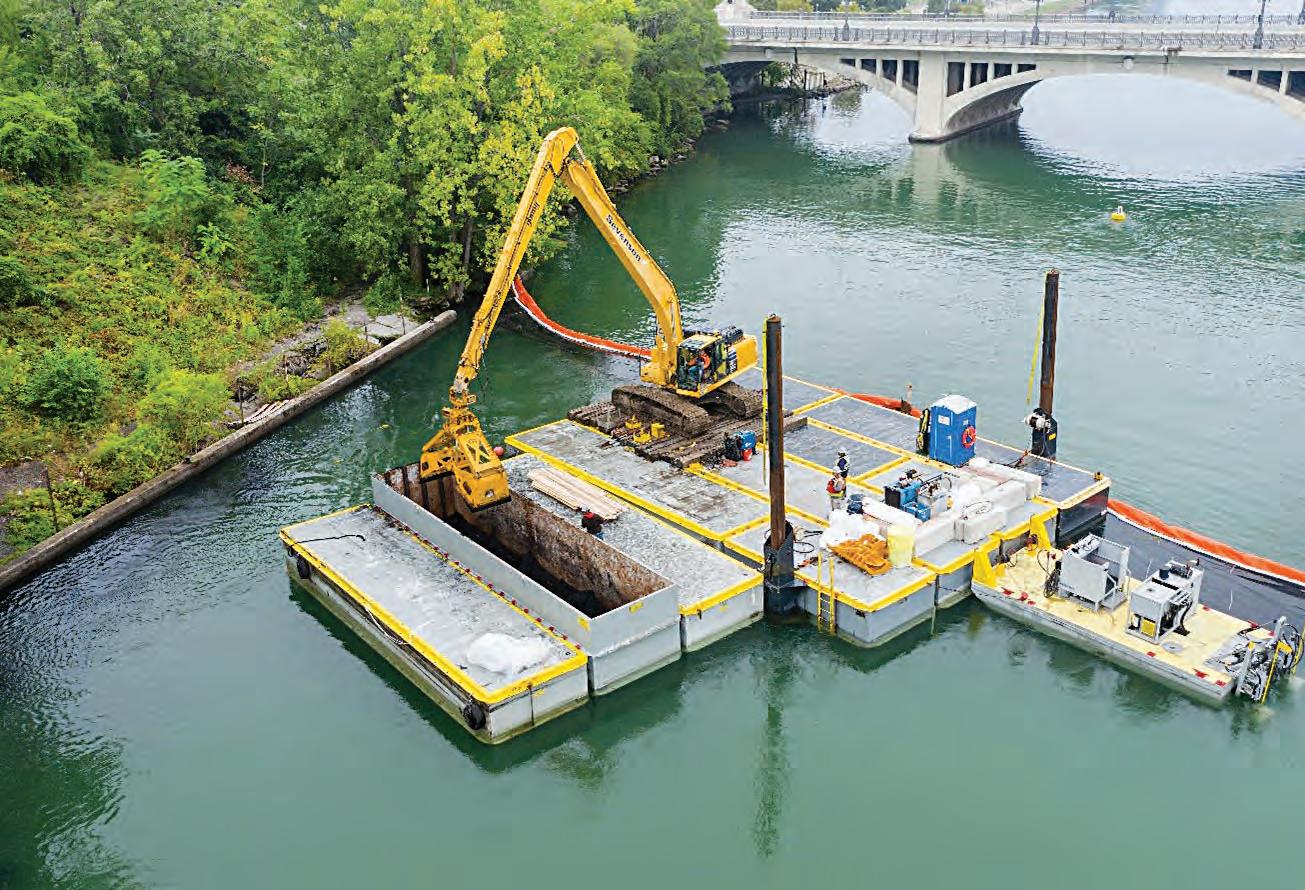
3 minute read
FUNDING
Continued from page 26
Collaborative Funding
Minnesota provides a good example of using state funds to match Great Lakes Legacy Act funds for sediment remediation.
In 2008, Minnesota’s voters passed the Clean Water, Land, and Legacy Amendment to the Minnesota Constitution to protect drinking water, protect and restore habitats, preserve arts and culture, support parks and trails and protect and restore surface and groundwater.
During 2010-2018, over $19 million in Minnesota Water, Land, and Legacy funding was used to help make a match on contaminated sediment remediation in the St. Louis River Area of Concern in Duluth.
In 1998, Michigan voters authorized the state to borrow $675 million for the Clean Michigan Initiative. This initiative helped clean up and redevelop contaminated sites, clean up contaminated sediments in rivers and lakes, protect and improve water quality, prevent pollution, abate lead contamination, reclaim and revitalize community waterfronts, and enhance recreational opportunities.
A good example of the benefits of the Clean Michigan Initiative was the cleanup of the former Black Lagoon on the Detroit River’s Trenton Channel.
In 2004 and 2005, the U.S. EPA and the Michigan Department of Environmental Quality removed 88,000 cubic meters of severely contaminated sediment from Black Lagoon at a cost of $9.3 million. Sixtyfive percent of the funds came from the Great Lakes Legacy Act and 35 percent from the Clean Michigan Initiative. It was the first fully funded project of the Great Lakes Legacy Act in the Great Lakes and was considered a major success in removing environmental blight from the Downriver area.
Upon completion of this project, the Black Lagoon was renamed Ellias Cove in honor of the family who donated the adjacent land to Trenton which became Meyer-Ellias Park. However, as funds in the Clean Michigan Initiative were depleted and no new funding was obtained, it lost its effectiveness.
In 2019, the Renew Michigan fund was created within the Michigan Department of Treasury to promote the cleanup of contaminated sites, waste management, and recycling. Initially, it received $69 million.
A good example of how the Renew Michigan fund has helped make the match requirements on contaminated sediment remediation projects in the Detroit River is the Ralph C. Wilson, Jr. Centennial Park under construction on the Detroit Riverwalk.
The Detroit Riverfront Conservancy has received a $1 million grant from Renew Michigan fund to help make a match on a nearly $30 million project to remediate contaminated sediment, restore habitats, and create a water garden that will be the centerpiece of the park.
The U.S. EPA is providing about $19 million through the Great Lakes Legacy Act and the Great Lakes Restoration Initiative. The balance of the funds is being provided by the Detroit Riverfront Conservancy, with $1 million being provided by the Renew Michigan fund. This Renew Michigan funding was essential in realizing the vision of Ralph C. Wilson, Jr. Centennial Park.
However, the Renew Michigan fund is not adequately funded to meet the estimated $100 million non-federal match requirements for the remaining sediment remediation in both the Detroit and Rouge Rivers.
One way of doing this in Michigan would be to secure a “special appropriation” for Michigan EGLE to help make the necessary match on this much-needed contaminated sediment remediation. As of January, Michigan was estimated to have a $9 billion surplus.
State environmental officials are ready and willing to work with all partners who are willing to step up with match money to clean up the rivers.
“The Michigan Department of Environment Great Lakes and Energy has a long history of working with the U.S. EPA on contaminated sediment cleanups and is currently working with this agency on the search for all possible partners, including industrial, governmental, and nongovernmental organizations to take advantage of these funds,” said Michael Alexander, Environmental Manager at Michigan EGLE.
“If lawmakers decide to prioritize our tax dollars for this purpose, we are ready to continue this partnership to ensure these funds are invested to bring about the most cost efficient and environmentally appropriate cleanups for the Detroit and Rouge Rivers Great Lakes Areas of Concern.”
Michigan State Senator Stephanie Chang, District 3 is advocating for this funding and said: “Cleaning up the Detroit and Rouge Rivers must be a priority. Water is life, and our communities are deeply connected to our rivers. We have a great opportunity in this moment to provide matching state funds to remediate the sediment in our precious rivers and utilize Great Lakes Legacy Act federal funding. I’m hopeful that the state can step up to help make this happen for the good of our environment and public health.”
Clearly, there must be a sense of urgency to raise the non-federal match dollars because there are only about four to five years left of federal Great Lakes Legacy Act funding. If this window of opportunity is missed, there is no guarantee that comparable federal money will be available in the future. This is a long-standing problem in our region, and we have a once-ina-century opportunity to address it for both present and future generations.
John Hartig is a board member at the Detroit Riverfront Conservancy. He serves as a Visiting Scholar at the University of Windsor’s Great Lakes Institute for Environmental Research and has written numerous books and publications on the environment and the Great Lakes. Hartig also helped create the Detroit River International Wildlife Refuge, where he worked for 14 years as the refuge manager.
Reprinted with permission from Great Lakes Now.










